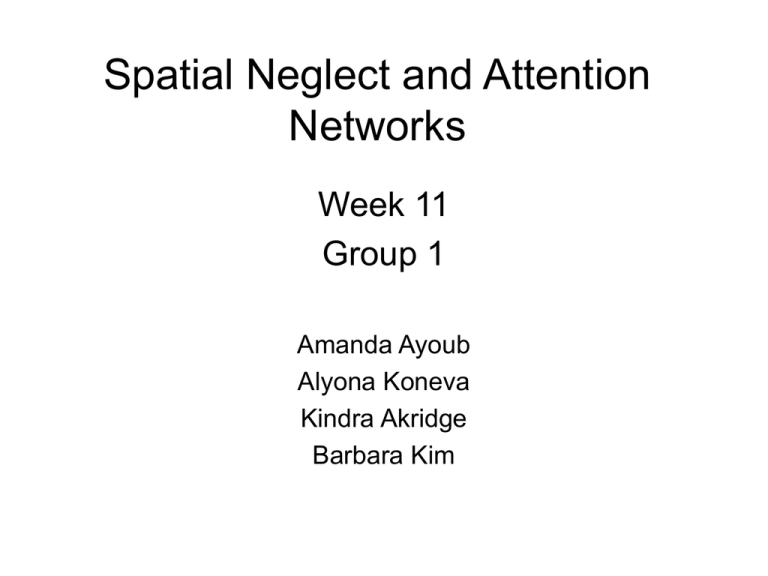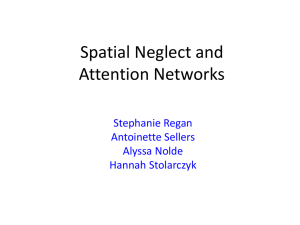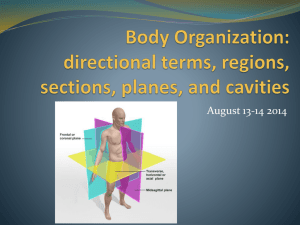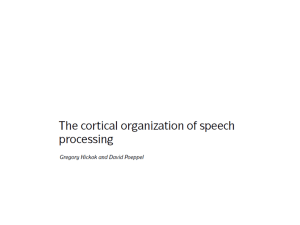4. Show us a picture of the frontoparietal network
advertisement

Spatial Neglect and Attention Networks Week 11 Group 1 Amanda Ayoub Alyona Koneva Kindra Akridge Barbara Kim 1. Describe the features of unilateral Spatial neglect Key features of unilateral spatial neglect: 1. Reduction of arousal 2. Reduction of processing speed 3. Inability to attend to and report stimuli on the side opposite the lesion (contralesional) 4. Spatial bias for direction actions toward the hemispace or hemi-body on the same side as the lesions (ipsilesional) 5. Several disorders of awareness, including a degree of obliviousness toward being ill and confabulation about body ownership 1. What part of the brain is normally involved in permanent dysfunction? • Only right hemisphere lesions cause severe and persistent deficits • Ventral lesions in right parietal, temporal, and frontal cortex are involved in neglect 2. If verbal commands can overcome symptoms, what does this tell us? It is possible that the neural mechanisms underlying the spatial deficits can be changed by signals from other parts of the brain reflecting exogenous attention. In other words, other parts of the brain can compensate for the impaired network between the dorsal frontoparietal network and the ventral frontoparietal network. DORSAL FRONTOPARIETAL VENTRAL FRONTOPARIETAL 2. What are non-spatial deficits in neglect? • Reorienting of attention impaired with unexpected events. • Especially large deficits in noticing contralesional targets when expectation of ipsilesional target. (TPJ lesions) • Suggests a deficit in disengaging attention from ipsilesional field – increased after VFC lesions. • Indicates bilateral deficit in reorienting. 2. What are non-spatial deficits in neglect? Deficits in target detection • Simple auditory reaction time (RT) is much slower following right hemisphere damage. • RT slowing may reflect damage to right hemisphere brain regions specifically associated with neglect • Abnormally slow simple RTs to an ipsilesional auditory stimulus 2. What are non-spatial deficits in neglect? • Arousal and vigilance • Arousal is the combination of autonomic, electrophysiological, and behavioral activity that is associated with an alert state. Vigilance refers to the ability to sustain this state over time. • Important part of neglect following right hemisphere injury. • Neglect patients with right hemisphere injuries suffer from lower arousal than patients with similar lesions in the left hemisphere. Parietal neglect patients show a vigilance decrement Task: detection of letter targets in two locations (arrows) within a central column L. J. the 58-year-old schoolteacher • Reduced vigilance • Grammatically correct but delayed responses • Normal visual fields, but gaze spontaneously deviated to the right when looking straight ahead • When presented with two objects he always looked first to the object on the right, denying the presence of the object on the left. • But when asked was able to move his eyes to the object on the left and report seeing it. 3. Explain the authors’ model: the different networks, and areas that are not damaged but whose function is changed. • Ventral lesions change the physiology of undamaged dorsal frontoparietal regions – the interaction between dorsal and ventral networks in impaired, even though the dorsal area is undamaged. • Model predicts that problems with attention correlate with impaired inter-hemispheric interactions or response imbalances between the left and right hemisphere dorsal network. 4. Show us a picture of the frontoparietal network: Dorsal and ventral frontoparietal networks and their anatomical relationship with regions of damage in patients with unilateral neglect Areas in blue indicate the dorsal frontoparietal network Areas in orange indicate the stimulus-driven ventral frontoparietal network 5. List which functional changes are direct results of damage to the substrate of that (those) function(s), and regions that change function even though they are not directly damaged. The dorsal frontoparietal area is not damaged in spatial neglect, but the network between the dorsal and ventral areas becomes dysfunctional. The Dorsal frontoparietal network controls attention, eye movements & represents stimulus saliency – Dysfunction here results in spatial deficits, a bias in spatial attention and salience in an egocentric frame of reference. – Dysfunction of top down modulation of visual cortex, reducing response. 5. List which functional changes are direct results of damage to the substrate of that (those) function(s), and regions that change function even though they are not directly damaged. • Structural damage to Ventral regions that partly overlap with a right hemisphere dominant ventral frontoparietal network – Deficits in arousal, reorienting, and detection – recruited during reorienting and detection of novel behaviorally relevant events. 6. Explain this: We argue that lateralization of these latter functions, and their interaction with dorsal regions, rather than asymmetries of spatial attention per se, primarily accounts for the hemispheric asymmetry of neglect. Ventral frontoparietal regions • Dorsal frontoparietal regions – Control spatial attention and eye -Not symmetrically organized movements -Core nonspatial deficits observed in neglect patients – Largely symmetrically organized are strongly right – Each hemisphere predominantly hemisphere dominant representing the contralateral This means that because the side of space. ventral regions are interacting with the dorsal regions in the right hemisphere, they are causing asymmetry of neglect instead of just asymmetry of spatial attention






